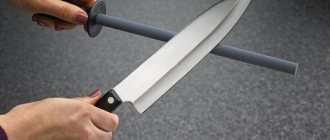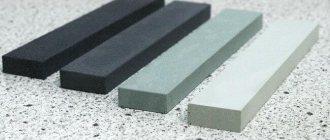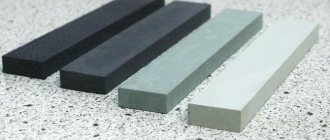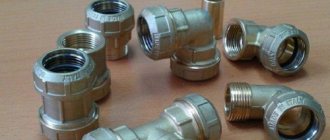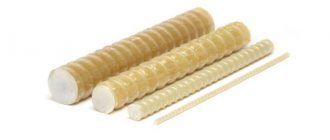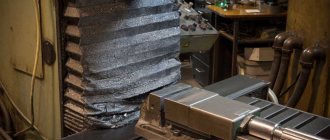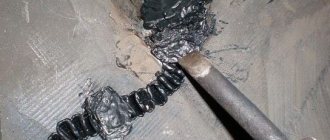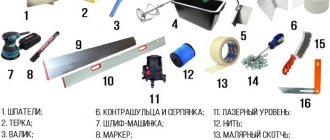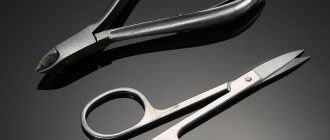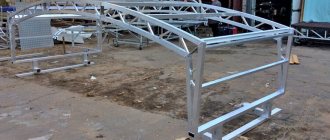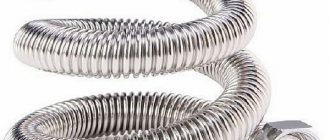Meet a new article from Arsenal Masters RU specialists. All about sharpening stones. Classification, types of stones. Recommendations and advice on the selection, storage and alignment of stones, and the process of sharpening tools.
There are many sharpening stones, it’s difficult to choose, and there are also many nuances and features. We have collected information on them and added tips and recommendations. We are waiting for your feedback, share your experience!
Classification of sharpening stones
There are synthetic and natural stones.
- Synthetic stones are divided according to the type of material into water, ceramic and diamond.
- Natural stones work with water or oil.
The wide selection of stones is also due to the different grain sizes of abrasive stones. This allows you to remove chips, remove minor damage, and bring the sharpened surface to “zero.” In practice, water stones are more often used.
The popularity of manual sharpening is easily explained:
- The hardness and edge of the steel does not deteriorate because no heat is generated.
- A huge selection of grain sizes allows for any fine sharpening.
- Precise cutting geometry (no rounded chamfer surfaces such as felt or rubber discs).
- No expensive equipment needed.
- In their practice, Masters reach perfection!
How to Make Dull Blades Sharp: Dull blades have a rounded edge on the cutting edge, therefore, when sharpening, it is necessary to remove material from the chamfer surfaces to again achieve the perfect “intersection” of the 2 planes of the blade chamfer.
Question answer
How to clean the bar when it gets dirty?
Under running water using a not very hard brush. Many people wipe off traces of the suspension after drying with a regular eraser.
What else can you sharpen and trim stones besides knives?
Relatively speaking, everything that is less hard and preferably plastic (metal): scissors, chisels, manicure tools, axes, scythes and sickles (if you are making a film about the harvest in pre-revolutionary Russia).
What oil should I use when sharpening with Arkansas?
In general, this is not important, since any oil will give the desired effect. Considering that knives can be used for cooking, you can take edible vegetable oil - olive, linseed. For tourist and technical knives, a spindle or ballistol is better suited.
Using a stone to sharpen knives indicates that a person loves knives and does not mind spending a few minutes (or tens of minutes) on sharpening and finishing. Well, a good sharpening stone pays its owner with good results.
Synthetic water stones
These are the most popular and productive abrasive stones. They have an open-pore microstructure with the inclusion of homogeneous particles; the abrasive grain is quickly crushed. Requires correction when worn.
Structure of synthetic abrasive stones Sharpening stones mainly consist of a binder (matrix) in which abrasive particles (alumina, carbides, natural semi-precious stones, diamond dust) are embedded.
The effectiveness of the stone depends on the combination of the hardness of the binder and the quality of the abrasive particles. The binding agents used in synthetic water stones are generally dye-like substances, whose hardness can be determined by composition and firing temperature level. Open structure Closed structure Abrasive stone materials
Silicon carbide abrasive is very effective and is therefore used for coarse abrasive stones, while corundum is used for finer abrasive stones.
Binder
The soft bond allows the abrasive particles to be constantly exposed during use, making the stone very effective. These stones are ideal for extremely hard low alloy steels. Tool steels with coarse-grained alloy components (for example, chromium and vanadium) require a stone that wears slower and holds its shape longer. The binder is stronger - the stone remains flat longer.
HOW TO USE SYNTHETIC WATER STONES
Before use, stones must be soaked in water for 10-15 minutes. Water serves as a washing medium, which prevents clogging of the stone pores with abrasive particles and preserves its abrasive properties. If it is not sufficiently rinsed with water, the abrasive debris becomes a paste that reduces the abrasive properties of the stone. ON A NOTE! Professionals actively use this fact. By using it, they achieve a finer abrasion, compensating for the large steps in grit when moving from a coarser stone to a fine-grained stone. Most aqueous (water) stones have a fairly soft, open-pore compound that continually exposes fresh abrasive particles during sharpening, resulting in high efficiency. As a result of wear, regular adjustment of water stones is required.
Item: MT #1010 Sharpening Stone #1000Japanese abrasive stone Suehiro Cerax 1000 grit on a stand with nagura M00013149 | Article: MT #3000 Sharpening Stone #3000Japanese sharpening abrasive 3000 grit Suehiro New Cerax 206x73x23mm stand with Suehiro nagura | Article: MT #GMN-150Sharpening abrasive 15000 Suehiro Gokumyo 205 x 73 x 20 mm stand with restoration stone Suehiro |
Sharpening stones for machine tools
Sharpening stones for machine tools vary in shape and composition. They can be used for sharpening not only cutting tools, but also any other metal products. Most often you can find a stone made of silicon carbide, but the most durable is considered to be CBN - an abrasive material based on boron nitride, which makes the tool as durable as possible.
All sharpening stone attachments for machines are divided into two types: black – the most resistant/strong and green. The first is used for rough sharpening of the cutting surface, while green is used to bring it to the desired state.
Sharpening machine 150 mm Titan BNS25-150
Ceramic stones
A relative innovation are ceramic water stones with particularly high wear resistance for professional use. Ceramic stones have a very strong bond and show little wear. However, to achieve good sharpening performance, it is necessary to use very high quality and wear-resistant abrasive particles (such as Shapton). Shapton ceramic stones hardly absorb water. With them, 1 minute of soaking is enough.
Diamond stones
. As an alternative to Japanese water stones, you can use diamond sharpening stones. In these whetstones, abrasive diamond granules are deposited in a nickel matrix as a thin layer on a metal substrate. They provide high flatness, durability, provided that the diamonds are of high quality (monocrystalline). The diamonds are applied to an extremely flat, warp-resistant and unbreakable base plate. Thus, diamond stones are extremely wear-resistant and do not chip like abrasive grains. High-quality monocrystalline diamonds guarantee remarkable sharpening speed even when working with the hardest high-alloy tool steels. It is recommended to moisten diamond stones with water and grind with light pressure. Made from high-quality single-crystal diamonds, DMT stones (USA) are especially wear-resistant and are famous for their perfectly smooth surface. DiaSharp 220 COARSE (Coarse) DMT D8X stone is recommended as a complement to water stones. It's great for finishing the backs of flat chisels, chisels, or leveling water stones. Warning: Avoid cheap products that are usually made from (short-lived) polycrystalline diamond dust.
Article: DMT D8EEDiamond abrasive stone DiaSharp 200 x 76 mm 8000 grit beige DMT D8EE | Article: DMT W250EFWBDouble-sided diamond abrasive stone DMT DuoSharp 250 x 100 mm 1200 / 600 grit X-Fine / Fine | Article: DSS-115FCMT DSS-115F Diamond whetstone, fine grain D25 in leather case 115 x 25 x 3 mm red |
What types of sharpening stones for knives are there?
Sharpening stones for knives are divided into two main types - natural and synthetic.
| Natural | Synthetic |
| Consist of minerals mined as minerals | Made from heavy-duty materials bonded together at high temperatures during processing |
| Two subspecies are considered popular - Arkansas and Japanese | There are 3 main subtypes - diamond, water and ceramic |
| There are 3 strength classes - soft, medium, hard | Features a long service life |
Water
Sharpening water stones (wet) belong to the category of artificial (synthetic), made from carbide and oxides of silicon, aluminum, and chromium. The production technology of this tool is such that the presence of particles of different sizes in the structure of the stone is not allowed - this negatively affects the results of sharpening cutting devices.
Depending on what binder material is used in production, water stone can have different hardness. For example, if the “bundle” is ceramic, then this indicator will be high, and if bakelite is used, it will be lower.
The peculiarity of a water (wet) whetstone is the need to soak it before starting work. Depending on the grit level of a particular instrument, soaking time can vary from 5 minutes (coarse grain) to 15 minutes (fine grain). You can tell that the tool is ready for use by looking at the air bubbles in the water - as soon as they stop forming, you can start sharpening the cutting surfaces.
Russian water stones Petrograd Water stones RUBANKOV.NET Sharpening water stones GRINDERMAN Chinese water stone
After soaking, the grinding surface is an accumulation of a mass of water, tiny metal particles and abrasive chips. This ensures uniform sharpening of the entire cutting surface.
Emery
Emery whetstones are used for electric machines that are equipped with grinding wheels (“emery pads”). At home, you should use white emery stones - they are durable, suitable for sharpening soft metals, and can be used for straightening knives and scissors. The composition of the material is soft, the temperature when the metal rubs against the stone is low, and the result is a fairly high-quality sharpening of tools.
There are also green sanding stones that are designed for working with hard metals. They have a high friction temperature, so they are not used for sharpening kitchen knives and scissors - scale will instantly appear on the blade, and the cutting surface will be hopelessly damaged.
Green grinding wheel White grinding wheel
Sandstone grits can be 8, 12, 16, 25 and 40, with 8 being the finest surface grit and 40 being the coarsest.
Diamond
Diamond is recognized as the hardest mineral in the world, it is used in the manufacture of sharpening tools with different grain sizes. The working layer of this mineral is made very thin, because the material is too expensive, but this does not affect the service life of the sharpening stones. It is believed that you can use such a sharpening tool for 10 years or more.
Diamond sharpening stones act very aggressively on the cutting surface and, although they allow you to complete the process in a few minutes, they quickly render it unusable and cause breakage of knives and scissors. Experts recommend that beginners limit themselves to medium-grained bars without such coating.
The difference between a diamond sharpening stone is that its surface is not clogged with foreign particles , so after use the tool is simply rinsed with cold water.
Watch the video about budget diamond sharpening stones:
A really high-quality stone of this type is quite expensive, but if you buy cheaper analogues, the surface will wear away very quickly. Accordingly, the service life will be reduced significantly.
Ceramic
The most modern type of abrasive stones is ceramic, in the production of which special materials are used (they are also used for the production of microcircuits). Ceramic can be used directly to make bars for sharpening cutting surfaces or an abrasive surface.
Sharpening tools on ceramics takes a long time and slowly; often such stones have a specific shape, which allows craftsmen to sharpen needles, nail scissors, fishing hooks, and blades. To begin work, ceramic stones are not wetted with water, but must be washed at the end of the process.
Ceramic stone (alumina ceramic) Fine Grit Tojiro F-472 – Ceramic water stone
Natural
The most popular are Arkansas and Japanese. Arkansas stones are a natural combination of quartz and rocks. The materials for its manufacture are mined in America, but their reserves are strictly limited, so the cost of such an instrument is always very high.
The second subtype of natural stone is Japanese waterstone. The material is mined in many regions of the country, but due to restrictions on its extraction, the cost of a sharpening tool will be “obscenely high.”
Professional natural stone Arkansas Translucent 1200 grit Japanese water stone S-3000/1000 on a stand
Oily
Oil sharpening stones are made from durable ceramics and have a longer service life because a more durable binder material is used in production. The peculiarity of oil whetstones is the variety of their shapes, which makes it possible to work with non-standard tools such as “bread” knives and serrated ones.
The surface of the stones has absolutely the same grain size, and this significantly speeds up work on them. There is also a drawback: it is impossible to achieve a “mirror” surface of the blade; it is better to use them at the “grinding” stage, when you need to make the blade thinner or remove small defects from its surface.
Watch the video review of Washita natural oil stone:
Round
Round sharpening stones are used for working on machine tools. They can be made from different materials, but more often they are synthetic - the machine produces too high speeds, so the hardness of the device must be maximum so that the blade or the stone itself does not collapse during operation.
The slipper type of tool is also available in small sizes; it is a cylinder that can be used to sharpen any knives. Manufacturers warn that it is impossible to achieve a perfect result with such stones, but they are effective as a “correction”.
Round whetstone
Natural water stones
Natural stones, including the Belgian Brocken or the Slovakian Rozsutec, are sedimentary or calcareous rocks with embedded corundum, oxides, quartzites or semi-precious stones (such as garnets). Due to their slightly heterogeneous structure, they combine particularly well with hand-forged steel.
Arkansas Novaculite sharpening stones are very dense and wear-resistant. They are well suited for straightening chisels for wood carving and turning tools. ATTENTION : It is not recommended to combine oil (ordinary abrasive) and water stones together, as oil reduces the effect of the stones. Look at natural stones Nagura, ARKANSAS
Article: Di 711518Natural Japanese water stone (Abrasive stone) Binsu 800-1200, 220*65*62 mm | Article: Di 711519Natural Japanese water stone (Abrasive stone) Amakusa 400-800, 220*65*65 |
Article: NB 895600Natural abrasive stone 6000-8000 100x40x12 mm Arkansas white Narex | Article: MT#NAGURA-200/711301Nagura Botan 3000 natural stone 50x40x30mm Miki Tool |
Natural oil stones
When combined with oil, some stones form a lubricating suspension that increases their effectiveness. Porous stones, for example Norton (India). The stone is usually pre-oiled, requiring only a few drops of honing oil on its surface before sharpening. Closed-cell stones only absorb small amounts of oil. A few drops of honing oil on their surface are enough. Unlike water, oil does not wash the stone, so it clogs faster. It can be cleaned by wiping it with oil. Check out Oil Stone Suehiro
Nuances
A classic straight razor (“safe”) allows a man to effectively deal with overgrown stubble on his face.
A good shave is only possible with a sharp blade. A straight razor should be sharpened at least once every 2-3 months.
The procedure can be done on your own at home. Its correct execution is the key to obtaining a good result.
Sharpening involves mechanical processing of the cutting edge of the tool.
You should sharpen the blade of the old “danger” in stages:
- Carrying out rough sharpening. The procedure is performed to restore or correct the geometry of the leads that form the cutting edge of the blade plate (sting). At this stage, the problem of chipping is solved, and the edge bends to the side are corrected.
- Finishing the tip and the blade plate itself. The manipulation is similar to honing in metalworking. At the second stage, the exact dimensions of the tip and the cleanliness of the blade surface are achieved. Finishing removes risks from the abrasive applied at the initial stage.
- Formation of an ultra-thin cutting edge by straightening it.
How to properly sharpen a dull straight razor yourself:
- sharpening is a manipulation associated with the risk of injury. Follow safety regulations!
- ensure that the straightening belts are tightly tensioned - this will avoid bending the cutting edge;
- be sure to determine the correct sharpening angle;
- Avoid pressing hard on the blade. Otherwise, there is a risk of damaging it. The blade must be in close contact with the surface of the sharpener at all times. ;
- When performing movements in both directions, try to keep the pressure on the blade equal. Otherwise, you won’t be able to sharpen the tool evenly;
- Cover the comb with tape in advance to prevent it from being scratched;
- You can sharpen the “harm” to maximum sharpness by bringing the thickness of the cutting edge to a minimum. However, the tip will become brittle.
The optimal indicator of sharpness for a razor is its ability to easily, effortlessly cut hair “in weight”.
Which sharpening stones to choose
Basic level:
As a basic equipment for manual sharpening, it is recommended (recommendation of the manufacturer DICTUM) a combination of stones with grits of 1000 and 6000 grit. This combination is minimally sufficient for editing and optimal for beginners. Purchasing a combined stone 1000/6000 with these grits will save money.
Article: Di 711007Japanese combined abrasive block 1000 / 6000 150x50x25 mm Sun Tiger 711007 | Article: Di 711006Japanese combined abrasive block 1000 / 6000 207x66x36 mm King 711006 | Article: Ver 05M0901-711005-AMSharpener Veritas Sharpening System II plus Japanese abrasive whetstone combined 1000 / 6000 King |
For advanced users:
- Coarse whetstone 220 grit (No. 711999) for chipping, dressing, etc. Japanese abrasive stone 220 King 711999
- Sharpening stone with grit 1000 - 1500 - for normal sharpening. For example Natural Japanese water stone Jyo-Haku 1000-1500 711620
- The correct stone with a grit of 6000 is for polishing and straightening edges. Example Sharpening abrasive 6000 Suehiro with nagura Suehiro white MT 6000 M00014380
- Nagura Cleansing Stone
For grooved chisels - cutters - you will additionally need:
- Shaped stone with 4000 grit - for straightening the inside. Example Abrasive water stone PETROGRAD BREEZE 4000 M00015241
- Nagura Cleansing Stone
For all:
- Straightening block for precise dressing of uneven water stones (Strutting stone 100 grit 711299)
- Whetstone holder
See everything for sharpening from Dictum
Sharpening stone: what is it, what does a whetstone mean?
A sharpening stone is a tool that belongs to the category of universal ones and is used for the full maintenance of knives, razors, scissors and other objects with a cutting edge.
They are considered the optimal choice for sharpening because they allow you to independently choose the intensity of processing of the cutting edge and adjust the pressure force - this is the main difference between sharpening stones and machines with high speeds, work on which often leads to damage to cutting tools.
The whetstone can come in different sizes, the smallest are called whetstones.
| Materials for making whetstones | Natural, synthetic |
| Coating grain | Small, medium, large |
| Types of whetstones | Diamond, ceramic, water, abrasive, emery and others |
| Production | Japan, Russia, USA, China |
| Price | From 300 rubles and above |
Grinding stone grit: table
When choosing a sharpening stone, pay attention to its grain size - a parameter that indicates the level of aggressiveness of the impact on the sharpening surface; its characteristics and types are presented in the table.
Too large grains on the surface of the whetstone leave grooves/scratches on the cutting surface; this is unacceptable for some materials and tools. And professionals consider a sharpened surface to be ideal if it is free of burrs and any other defects. Therefore, the coarse grain size of the stone is suitable for rough repair and restoration work.
If you use a sharpening stone with a fine-grained surface, the quality of the work will be very high, but it will take a really long time to get the desired result. Experienced sharpeners recommend having sharpening stones with different grit levels available in order to start the process with rough sharpening and finish with bringing the cutting surface to “ideal”.
Stones from the Small NANIWA Flattening Stone series of various grain sizes
What is grit
Grit, grit is the level of grit of sharpening stones. This technical parameter is indicated in numbers, for example: if we are talking about a stone with a grain size of 120 grit, then it is used for rough sharpening of the cutting surface (coarse grain), finishing the sharpening work with fine grain stones (1200, 3000, 8000 grit).
Sets of sharpening stones
To provide you with the best basic equipment for different tools and steels, we have collected various sharpening sets for you. You can choose a set of sharpening stones that suits you.
Article: RN Set N4: 150, 360, 500. 1000, 1500, 2000Sharpening set PETROGRAD N4 for sharpening knives 15 x 15 x 120 mm 6 stones (150, 500, 1000, 1500, 2000, 4000 grit) | Article: M00003437-M00017823-M00014093-AMStarter set for sharpening knives, planes and chisels Petrograd No. 1: Sharpener, protractor and set of sharpening stones | Article: Arma21Starter set for sharpening knives, planes and chisels N 3: cradle box, sharpener, template, protractor and set of sharpening stones |
Sharpening methods
To get a good result, skill is required. It is more convenient to use a sharpening belt at home. It is more difficult to master sharpening with a stone. It only takes one wrong move to damage your razor.
Experts recommend using a whetstone as a last resort - when it is not possible to sharpen the blade to a sharp point with a belt.
On the stone
View this post on Instagram
Publication from Sharpening knives
